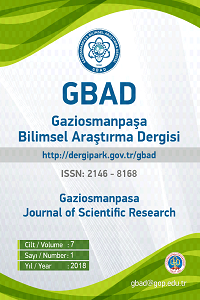Teucrium polium L. Uçucu Yağının Herbisidal ve Antifungal Etkileri ile Kimyasal İçeriğinin Belirlenmesi
Çalışmada, aktarlarda ticari olarak satılan ve halk arasında özellikle çay, baharat ve tıbbi amaçlı tüketilen peryavşanı (Teucrium polium L.) uçucu yağının herbisidal ve antifungal aktiviteleri ile kimyasal içeriğinin belirlenmesi amaçlanmıştır. Elde edilen uçucu yağın GC-MS ile analizi sonucunda, delta-3-carene (% 24.61), 2-β-pinene (% 15.75), β-mycrene (% 8.02), germacrene (% 5.43) ve carvacrol (% 4.27) temel bileşenler olarak belirlenmiştir. Herbisidal etkiyi belirlemek için yürütülen petri çalışmalarında test bitkisi olarak Lepidium sativum L., Solanum lycopersicum L., Medicago sativa L., Abutilon theophrasti Medic. ve Sinapis arvensis L. kullanılmıştır. Uçucu yağ 4 ayrı konsantrasyonda (0-Kontrol, 1, 3, 5 ve 7 μl/petri) uygulanmıştır. Çalışmada, uçucu yağın L. sativum, S. lycopersicum, M. sativa, A. theophrasti, S. arvensis test bitkilerinde tohum çimlenmesini sırasıyla % 78, % 87, % 48, % 97 ve % 68 oranında engellediği bulunmuştur. Benzer sonuçlar kök ve sürgün gelişiminde de görülmüştür. Bunun yanı sıra, T. polium uçucu yağının Alternaria solani ve Fusarium oxysporium patojenlerine karşı antifungal aktivitesi petri çalışması şeklinde yürütülmüştür. Hazırlanan 200 ml’lik PDA besiyerlerine 0 (Kontrol), 125, 250 ve 500 ppm oranında uçucu yağlar ilave edilerek dozlar hazırlanmıştır. Besiyeri eklenen petri kaplarına, 5 mm çapında fungus misel diskleri aktarılarak 7 gün gelişimleri gözlemlenmiştir. İnkübasyon süresi sonunda miselyum gelişimleri kumpast ile ölçülerek kontrolle karşılaştırılmıştır. T. polium uçucu yağının A. solani miselyum gelişimini kısmen azalttığı saptansa da antifungal aktivitesinin yeterli düzeyde olmadığı saptanmıştır.
Anahtar Kelimeler:
Teucrium polium L., uçucu yağ, herbisidal etki, antifungal aktivite, kimyasal içerik
Chemical Composition, Antifungal and Herbicidal Effects of Essential Oil Isolated from Teucrium polium L.
The purposes of this study were to determine chemical composition of essential oils isolated from felty germander (Teucrium polium L.) and assess the herbicidal and antifungal activities of the essensial oil. Lepidium sativum L., Solanum lycopersicum L., Medicago sativa L., Abutilon theophrasti Medic., Sinapis arvensis L. were used as test plants to determine herbicidal activities of the essential oils in petri studies. Four different essential oil concentrations (0- control, 1, 3, 5 ve 7 µl/petri) were applied. The major components of essential oil in the plants were delta-3-carene (24.61%), 2-β-pinene (15.75%), β-mycrene (8.02%), germacrene (5.43%), carvacrol (4.27%) based on GC-MS analysis. The essential oil was inhibited the seed germination of L. sativum, S. lycopersicum, M. sativa, A. theophrasti, S. arvensis at a rate of 78%, 87%, 48%, 97%, and 68%, respectively. Root and shoot development of test plants were also suppressed with essential oil applications. Petri studies were also conducted to determine the antifungal activities of the essential oils on Alternaria solani and Fusarium oxysporium pathogens. Essential oil concentrations with 0 (control), 125, 250 and 500 ppm of were added to the 200 ml volume of medium. The 5 mm diameter fungus mycelium disks were incubated into the petri dishes and growth of fungus mycelium disks were monitored for seven days. At the end of the incubation period, mycelium developments were measured with a caliper and compared with control. Although A. solani mycelium growth was partially reduced by the essential oil application, the antifungal activity of the felty germander was not statistically important
Keywords:
Teucrium polium L., essential oil, herbicidal effect, antifungal activity, chemical composition,
- ISSN: 2146-8168
- Yayın Aralığı: Yılda 3 Sayı
- Başlangıç: 2012
- Yayıncı: Tokat Gaziosmanpaşa Üniversitesi
Sayıdaki Diğer Makaleler
Ailenin Çocuğun Eğitimine Etkin Katılımı: Öğretmen Adaylarının Görüşleri
Bayram TAY, Alper Murat ÖZDEMİR, Kasım YILDIRIM
Burdur-Kemer-Elmacık Köyü Arazi Toplulaştırma Etkinliğinin Değerlendirilmesi
P Cisimcikleri ve mRNA Döngüsü
Tuğba GÜRKÖK, Gülşen BOZTEPE, Mesut KOYUNCU, İskender PARMAKSIZ
